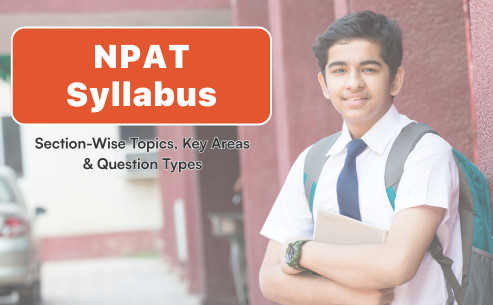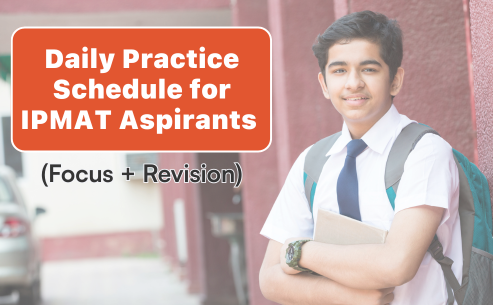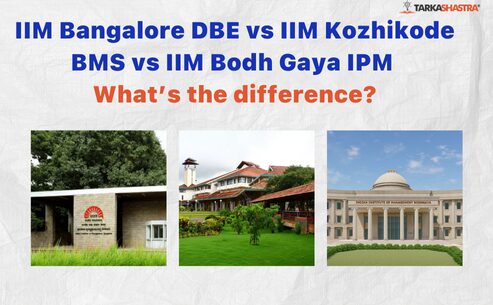The NMIMS Programs After Twelfth / National Test for Programs After Twelfth (NPAT) 2026 is the official entrance exam for admission into undergraduate programs like BBA, B.Com (Hons.), and B.Sc. Finance, Branding & Advertising, and other specialised courses are offered by NMIMS University across its campuses. Every year, thousands of aspirants compete for limited seats, making it one of the most sought-after UG entrance exams in India.
Aspirants often make the mistake of focusing only on test-taking strategies, without first mastering the syllabus and question types. However, understanding the NPAT 2026 syllabus in detail is the very first step toward structured preparation. Knowing what topics are included (and excluded) ensures that you don’t waste time on irrelevant areas and can prioritise high-weightage chapters.
The NPAT is designed to test your speed, accuracy, and conceptual clarity across three sections:
- Quantitative Reasoning
- Logical Reasoning
- Verbal Reasoning
This blog provides a section-wise breakdown of the NPAT 2026 syllabus, including key topics, question types, weightage, and preparation insights, along with expert tips to help you build a winning strategy.
Quick Fact: NPAT is a speed-intensive test – 120 questions to be solved in 120 minutes, making syllabus clarity + time management equally crucial.
NPAT 2026 Exam Overview
The NMIMS NPAT 2026 serves as the gateway to some of the most prestigious undergraduate programs offered by NMIMS University, including BBA, B.Com (Hons.), and B.Sc. Finance, Branding & Advertising, Liberal Arts, and International Business. It is designed to evaluate a student’s quantitative reasoning, logical ability, and verbal skills, which are essential for business and management studies.
The exam is computer-based (CBT) and follows a speed-driven format, where candidates must attempt 120 multiple-choice questions in 120 minutes. Each section carries equal weight, making it crucial for aspirants to maintain a balance across all areas rather than overemphasising just one.
NPAT 2026 Exam Highlights
| Feature | Details |
| Conducting Body | SVKM’s NMIMS (Narsee Monjee Institute of Management Studies) |
| Exam Name | NMIMS NPAT 2026 |
| Mode of Exam | Computer-Based Test (CBT) |
| Duration | 100 Minutes |
| Total Questions | 120 |
| Question Type | Multiple-Choice Questions (MCQs) |
| Sections | 1. Quantitative Reasoning 2. Logical Reasoning 3. Verbal Reasoning |
| Marking Scheme | +1 for every correct answer, No negative marking |
| Eligibility | Passed/Appearing Class 12 or equivalent (minimum % varies by course) |
| Programs Offered | BBA, B.Com (Hons.), B.Sc. Finance, Branding & Advertising, Liberal Arts, International Business, and more |
This section gives aspirants a quick snapshot of the exam format before we dive deep into the syllabus structure and section-wise topics.
NPAT 2026 Syllabus Structure at a Glance
The NPAT 2026 syllabus is divided into three major sections:
- Quantitative Reasoning – Tests number system, arithmetic, algebra, sets and function, elementary statistics and probability and trigonometry.
- Logical Reasoning – Measures critical thinking, verbal logical reasoning, data sufficiency, numeric reasoning, data interpretation, spatial reasoning.
- Verbal Reasoning – Evaluates grammar, vocabulary, error recognition, sequence of ideas, contextual usage, applied grammar and reading comprehension.
Each section carries equal weightage, making it essential for aspirants to focus on all three areas with a balanced preparation approach. The questions are designed to be speed-intensive yet moderate in difficulty, ensuring that clarity of concepts and effective time management go hand in hand.
NPAT 2026 Syllabus Snapshot
| Section | Approx. No. of Questions | Key Focus Areas | Difficulty Level |
| Quantitative Reasoning | ~40 | Number System, Arithmetic, Algebra, Sets and Function, Elementary Statistics and Probability and Trigonometry | Moderate |
| Logical Reasoning | ~40 | Critical Thinking, Verbal Logical Reasoning, Data Sufficiency, Numeric Reasoning, Data Interpretation, Spatial reasoning | Moderate |
| Verbal Reasoning | ~40 | Grammar, Vocabulary, Error Recognition, Sequence of Ideas, Contextual Usage, Applied Grammar and Reading Comprehension | Moderate |
This structured overview helps aspirants understand the scope of the exam at a glance before diving into detailed section-wise topics.
Detailed Section-Wise Syllabus
The NPAT 2026 syllabus is carefully designed to test a candidate’s numerical ability, logical reasoning, and English language proficiency. Below is a comprehensive, section-wise breakdown of all key topics and subtopics.
A. Quantitative Reasoning
This section assesses numerical ability and mathematical problem-solving skills. It includes both basic and advanced mathematics concepts.
| Topics | Sub-Topics |
| Number System | Fractions, Surds and Decimals, Number Series |
| Arithmetic | Percentages, Profit & Loss, Discount, Time, Work & Distance, Ratio & Proportions, Compound Interest & Annuities, 2D & 3D Figures – Areas & Volumes |
| Algebra | Basic Algebraic Identities, Linear & Quadratic Equations, Sequences & Series (AP & GP) |
| Sets and Functions | Venn Diagrams, Sets, Operations on Sets & their Applications, Functions |
| Elementary Statistics & Probability | Mean, Median, Mode, Measures of Dispersion |
| Trigonometry | Identities, Trigonometric Ratios, Height & Distance |
Question Types:
- Word problems based on arithmetic
- Caselet-based data interpretation
- Equation-solving and algebraic simplification
- Geometry and mensuration applications
- Probability and statistics calculations
B. Logical Reasoning
This section tests analytical ability, decision-making, and logical consistency.
| Topics | Sub-Topics |
| Critical Thinking | Problem-Solving, Decision Making |
| Spatial Reasoning | Figure Analogy, Figure Series, Figure Matching/Classification |
| Numerical Reasoning | Venn Diagrams, Mathematical Equalities |
| Verbal Logical Reasoning | Drawing conclusions from premises, Validity of arguments |
| Data Sufficiency | Checking adequacy of information to answer a question |
| Data Interpretation | Graphs, Charts, and Tables-based reasoning |
Question Types:
- Series (numeric/figural) completion
- Analytical puzzles and arrangements
- Venn diagram classification
- Syllogisms and conclusion-based reasoning
- Data sufficiency tests
C. Verbal Reasoning
This section evaluates a candidate’s English grammar, vocabulary, and comprehension skills.
| Topics | Sub-Topics |
| Vocabulary | Understanding meaning of highlighted/underlined words |
| Error Recognition | Identifying grammatical structure and usage |
| Sequencing of Ideas | Jumbled sentences, Logical arrangement |
| Contextual Usage | Using appropriate words in a given context |
| Applied Grammar | Tenses, Prepositions, Determiners, Connectives |
| Reading Comprehension | Locating Information, Grasping Ideas, Identifying Relationships, Interpreting Ideas, Moods, Evaluating, Inferring, Tone of Passage, Getting Central Theme, Characteristics of Characters (3 RC Passages of 400–500 words, ~5 questions each) |
Question Types:
- Spotting grammatical errors
- Sentence completion & correction
- Para-jumbles and sequencing ideas
- Vocabulary-based synonyms, antonyms, contextual meanings
- Reading comprehension with inference, tone, and theme-based questions
With this detailed section, aspirants now have a complete topic map for NPAT 2026, ensuring nothing important is missed.
Section-Wise Weightage & Question Distribution
The NPAT 2026 exam is designed to give equal weightage to all three sections, ensuring a balanced assessment of a candidate’s numerical, logical, and verbal abilities. Each section carries approximately the same number of questions, and candidates must manage their time efficiently to maximize their score.
NPAT 2026 Sectional Distribution
| Section | Approx. No. of Questions | Weightage (%) | Suggested Time Allocation |
| Quantitative Reasoning | ~40 | 33% | ~35 minutes |
| Logical Reasoning | ~40 | 33% | ~35 minutes |
| Verbal Reasoning | ~40 | 33% | ~30 minutes |
| Total | 120 | 100% | 100 minutes |
Key Insight:
Since there is no negative marking, candidates should aim to attempt all questions. However, maintaining accuracy is equally important because the competition level is high, and every correct answer adds value to your percentile.
This section provides a clear picture of question distribution and time management strategy before moving into difficulty analysis and expert preparation insights.
Preparation Tips for NPAT 2026 Syllabus
Cracking NPAT 2026 requires more than just syllabus knowledge — it demands strategy, time management, and consistent practice. Since the exam is speed-intensive (120 questions in 100 minutes) with equal weightage for all sections, aspirants should adopt a structured approach to maximize their performance.
General Preparation Strategy
- Know the Syllabus Inside-Out
- Focus on high-weightage topics like Arithmetic (Quantitative), Series & Puzzles (Logical), and Grammar & Vocabulary (Verbal).
- Create a topic-wise study plan to ensure balanced preparation.
- Build Speed with Accuracy
- NPAT is not just about solving questions but solving them quickly and correctly.
- Practice timed sectional tests to simulate exam conditions.
- Prioritize Mock Tests & Analysis
- Attempt full-length mocks regularly.
- After every test, analyze the mistakes to identify areas for improvement.
- Track progress section-wise and reattempt wrongly solved questions.
Section-Specific Preparation Tips
| Section | Preparation Tips |
| Quantitative Reasoning | Revise NCERT basics (Class 9–12) for Arithmetic and Algebra. Practice Data Interpretation daily. Focus on formulas for Geometry & Trigonometry. |
| Logical Reasoning | Solve puzzles and series-based questions daily. Practice Venn diagrams and data sufficiency. Strengthen analytical thinking with previous-year style problems. |
| Verbal Reasoning | Improve vocabulary with 10–15 new words daily. Revise grammar rules (tenses, subject-verb agreement, modifiers). Read newspapers/articles for RC practice. |
Time Management Strategy
- Allocate 35 minutes each for Quantitative Reasoning and Logical Reasoning, and 30 minutes for Verbal Reasoning.
- Avoid getting stuck on a single question — mark it and move ahead.
- Aim for a 90–95% attempt rate, as there is no negative marking.
Recommended Resources
- Books:
- Quant: RS Aggarwal (Quantitative Aptitude), Arun Sharma (DI & QA basics)
- Logical Reasoning: RS Aggarwal (Logical Reasoning)
- English: Norman Lewis (Word Power Made Easy), Wren & Martin (Grammar)
- Tarkashastra NPAT Resources:
- NPAT-specific e-books and hard copy study material
- Sectional & full-length mocks designed by expert mentors
- Mentor-led doubt-solving and strategy sessions
Pro Tip: Divide your last 30 days into 20 days of revision + 10 days of mock practice. This ensures your concepts are consolidated and speed is fine-tuned for exam day.
With these preparation insights, aspirants can now focus on structured learning and exam-day performance.
NPAT 2026 Question Types: What to Expect in the Exam
Understanding the types of questions asked in NPAT is as essential as knowing the syllabus. The exam is designed to check a student’s ability to apply concepts quickly under time pressure.
By practicing sample papers and previous year NPAT papers, aspirants can gain clarity on the difficulty level, question styles, and time management strategies.
Why Knowing Question Types Matters?
- Reflects Real Exam Complexity: NPAT sample papers closely mirror the actual test format, helping aspirants gauge the expected difficulty.
- A mix of Easy, moderate, and difficult questions: While some questions are straightforward, others require a deeper application of logic and concepts.
- Enhances Accuracy & Speed: Regular practice helps students learn how to avoid common mistakes, manage their time effectively, and improve accuracy.
Previously Asked NPAT Question
Quantitative Reasoning
- Given: f(x) = (1 + 1/x) and f(k) × f(k + 1) × f(k + 2) × … × f(k + 99) = 11.
Quantity A: k
Quantity B: 11
A. Quantity A is greater.
B. Quantity B is greater.
C. The two quantities are equal.
D. The relationship cannot be determined from the information given.
- 2. If x, y and z are positive integers and p = {[(x – 1)2 /x] + 2} + {[(y – 1)2 /y] + 2} + {[(z – 1)2 /z] + 2}, then p < 6.
A. Always
B. Sometimes
C. Never
- 3. If p and q are numbers such that the pair of linear equations (p + 2)x + (q – 1)y = 10 and (q + 2)x + (p – 1)y = 10 have infinite solutions of x and y, then p = q.
A. Always
B. Sometimes
C. Never
Logical Reasoning
- There are four questions based on the information below, one of which is asked alongside.
Manjeet, Rahim, Ram and Divya are four friends who live in a village. It is known that:
I. Each friend lives in a differently coloured house – orange, yellow, green and blue.
II. Each friend owns a different pet – Bee, Dee, Cee and Tee.
III. The pets each feed on different things – leaves, fish, vegetables and insects.
IV. Manjeet does not live in the blue house.
V. Tee eats leaves but does not live with Rahim or Divya.
VI. Dee does not eat insects.
VII. Ram lives in an orange house but does not own Cee or Tee.
VIII. The pet that feeds on insects does not live in the green or blue house.
IX. Rahim does not feed vegetables or insects to his pet, which is neither Dee nor Cee.
1. Which pet eats fish?
A. Bee
B. Cee
C. Dee
D. Manjeet’s pet
E. Cannot be determined
2. Who lives in the green house?
A. Divya
B. Manjeet
C. Divya or Rahim
D. Manjeet or Divya
E. Cannot be determined
3. What does Cee eat?
A. Fish
B. Insects
C. Vegetables
D. Either fish or vegetables
E. Cannot be determined
4. Who lives in the blue house?
A. Cee
B. Dee
C. Tee
D. Rahim
E. Divya
- Select the conclusion that best follows from the statement given below.
Statement:
In a library, some members were issued non-fiction non-academic books and these were returned exactly 3 weeks later. Some members were issued non-academic fiction books written by American authors and they returned these books within 20 days. More than half the members were issued academic textbooks and these were returned after 20 days.
Conclusions:
I. The non-academic fiction books were borrowed by library members for the shortest duration.
II. Most library members prefer to read non-academic non-fiction books.
III. Academic textbooks were perhaps the most issued books in the library.
IV. Non-academic fiction books are preferred more than non-academic non-fiction books by library members.
A. Only conclusion I follows
B. Only conclusion II follows
C. Only conclusion III follows
D. Both conclusions I and III follow
E. Both conclusions II and IV follow
- Select the conclusion that best follows from the statement given below.
Statement:
Some mangoes are exported to Europe and most mangoes are consumed in India. In India, some mangoes are used for preparing mango juice and some are used for making jellies. All mangoes are consumed by humans unless they are raw mangoes. All raw mangoes are exported outside India.
Conclusions:
I. All the mangoes exported to Europe are unfit for human consumption.
II. Mango juice can also be prepared with raw mangoes.
III. Most mangoes are consumed in India in the form of mango jelly.
IV. No raw mango was used to prepare jelly.
A. Only conclusion I follows
B. Only conclusion II follows
C. Only conclusion III follows
D. Only conclusion IV follows
E. None of the conclusions follow
Verbal Reasoning
- Select the option that best completes the sentence below.
Please pay the electricity bill ______ time to avoid having your electricity supply cut off.
A. inside
B. about
C. on
D. to
- Select the option that best completes the sentence below. Birds get very frightened when paper balls are thrown ______ them.
A. with
B. by
C. at
D. in
- Select the option that best completes the sentence below. ______ Buddhist beliefs and traditions, Gautam Buddha had been born as animals and humans in many previous births.
A. From
B. Besides
C. According to
D. In addition to
Pro Tips for Using NPAT Sample Papers Effectively
- Start with Easy Topics: Build confidence before moving to advanced ones.
- Simulate Exam Conditions: Time yourself strictly as you solve.
- Review & Analyze: Check answers, allot marks, and understand mistakes.
- Consistency: Solve at least 3 sample papers per week during revision.
- Mix of Difficulty Levels: Practice easy, moderate, and challenging sets to be exam-ready.
Key Insight: Practicing different NPAT question types regularly helps you build a balance between speed and accuracy, which is the ultimate success formula for NPAT 2026.
Conclusion
The NPAT 2026 syllabus is comprehensive, covering Quantitative Reasoning, Logical Reasoning, and Verbal Reasoning, each carrying equal weightage. Success in this exam is not about focusing on just one strong area but about maintaining balanced preparation across all three sections.
By now, you should be familiar with the detailed topic list, question types, weightage, and difficulty analysis. The key to cracking NPAT lies in:
- Building conceptual clarity in fundamentals.
- Practicing through sample papers and full-length mocks.
- Managing time smartly to attempt all questions, since there is no negative marking.
At Tarkashastra, our expert mentors provide NPAT-specific study material, e-books, sectional tests, and mocks, ensuring that you don’t waste time on irrelevant content. With the right mix of structured preparation and guided mentorship, you can significantly improve your chances of securing admission to top NMIMS programs.
Final Tip: Consistency and practice are your biggest allies. Begin early, revise smartly, and test yourself regularly — that’s the winning formula for NPAT 2026!
NPAT 2026 FAQs
1. What is the NPAT 2026 syllabus?
The NPAT 2026 syllabus comprises three sections: Quantitative Reasoning, Logical Reasoning, and Verbal Reasoning. Each section includes around 40 questions, focusing on arithmetic, puzzles, and English grammar & comprehension.
2. How many questions are there in NPAT 2026?
The NPAT 2026 exam consists of 120 multiple-choice questions to be solved in 100 minutes. Each section has equal weightage, and there is no negative marking.
3. Is NPAT tougher than IPMAT or SET?
NPAT is generally considered moderate in difficulty, with speed being the main challenge. Unlike IPMAT (which includes higher-level math) or SET (which has a GK section), NPAT is purely aptitude-based.
4. Which topics are most important in NPAT Quantitative Reasoning?
Key high-weightage topics include Percentages, profit and loss, Ratios, time and work, Time-Speed-Distance, Algebra, and Data Interpretation. Geometry and Probability also appear frequently.
5. What kind of questions are asked in NPAT Logical Reasoning?
NPAT Logical Reasoning questions include series, puzzles, syllogisms, Venn diagrams, coding-decoding, and critical reasoning. Many are analytical and require quick logical deductions.
6. How should I prepare for NPAT Verbal Reasoning?
Focus on grammar rules, vocabulary, and reading comprehension. Practice synonyms, antonyms, para jumbles, and tone-based RC questions to build accuracy and speed.
7. Is there any negative marking in NPAT 2026?
No, NPAT 2026 does not have negative marking. This means students should aim to attempt all questions while maintaining accuracy for a higher score.
8. How can NPAT sample papers help in preparation?
Solving NPAT sample papers and previous year papers helps you understand question types, improve speed, and analyze weak areas. Practicing under timed conditions builds exam confidence.
9. Which books are best for NPAT 2026 preparation?
Recommended books include RS Aggarwal (Quantitative Aptitude & Logical Reasoning), Word Power Made Easy (Norman Lewis), and Wren & Martin (Grammar). Aspirants should also use Tarkashastra NPAT-specific mocks and e-books for focused practice.
10. What is the duration of NPAT 2026?
The NPAT 2026 exam duration is 100 minutes (1 hour 40 minutes), with 120 questions divided equally across three sections.
11. Can I prepare for NPAT along with CUET or IPMAT?
Yes. NPAT preparation overlaps with CUET (aptitude) and IPMAT (quant & verbal). However, NPAT is more speed-focused, so regular mock practice is essential to adapt.
12. How many sample papers should I solve before NPAT 2026?
Ideally, you should solve 15–20 NPAT mock tests and previous papers before the exam. This ensures familiarity with question styles and builds exam temperament.







